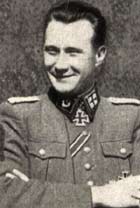Harald Riipalu
This article includes a list ofgeneral references,butit lacks sufficient correspondinginline citations.(January 2013) |
Harald Riipalu | |
|---|---|
 Harald Riipalu in 1944 | |
| Born | 13 February 1912 Saint Petersburg,Russian Empire |
| Died | 4 April 1961(aged 49) West Yorkshire, England,United Kingdom |
| Allegiance | Estonia,Soviet Union,Nazi Germany |
| Service | Estonian Army Red Army Wehrmacht Waffen-SS |
| Years of service | 1935–45 |
| Rank | Obersturmbannführer |
| Unit | 20th Waffen Grenadier Division of the SS (1st Estonian) |
| Commands | 36th Estonian Police Battalion |
| Battles / wars | World War II Eastern Front |
| Awards | Knight's Cross of the Iron Cross |
Harald Riipalu(born asHarald Reibach) (13 February 1912 – 4 April 1961) was anEstoniancommander in the GermanWehrmachtand theWaffen-SSduringWorld War II.He was a recipient of theKnight's Cross of the Iron CrossofNazi Germany.
Career
[edit]After theSoviet occupation of Estoniain 1940, Riipalu was forcibly mobilized into theSoviet Army22nd Territorial Corps,serving until 1941, at which time he defected to the German side.
From 1942 to 1943 Riipalu was a platoon leader and company commander of the36th Estonian Police Battalion,and became commander of the battalion in November 1942.[1]
From 1943 to 1945, he served in the 3rd SS-Brigade and the20th Waffen Grenadier Division of the SS.He was the Commander of the 45th SS-Grenadier Regiment from April 1944. On 23 August 1944 he was decorated with theKnight's Cross of the Iron Crossfor his actions in theBattle of Tannenberg Lineand in theBattle of Auverewhere Riipalu and his regiment drove back the assault of the Soviet Army, which prevented the encirclement of Army Detachment Narwa. The award was presented to him byFelix Steiner,the commander ofIII SS Panzer Corps.
After the end of the war, Riipalu evaded Soviet captivity by fleeing to Denmark. He died inGreat Britainin 1961.
Awards
[edit]- Knight's Cross of the Iron Crosson 23 August 1944 as Waffen-Obersturmbannführerand commander of Waffen-Grenadier-Regiment der SS 45 (estnische Nr. 1).[2]
References
[edit]Citations
[edit]- ^Aivar Niglas;Toomas Hiio[in Estonian](2006). "Estonian defence battalions / police battalions". In Toomas Hiio; Meelis Maripuu; Indrek Paavle (eds.).Estonia 1940–1945: Reports of theEstonian International Commission for the Investigation of Crimes Against Humanity.Tallinn. pp. 825–876.
{{cite book}}:CS1 maint: location missing publisher (link) - ^Scherzer 2007, p. 630.
Bibliography
[edit]- Scherzer, Veit (2007).Die Ritterkreuzträger 1939–1945 Die Inhaber des Ritterkreuzes des Eisernen Kreuzes 1939 von Heer, Luftwaffe, Kriegsmarine, Waffen-SS, Volkssturm sowie mit Deutschland verbündeter Streitkräfte nach den Unterlagen des Bundesarchives[The Knight's Cross Bearers 1939–1945 The Holders of the Knight's Cross of the Iron Cross 1939 by Army, Air Force, Navy, Waffen-SS, Volkssturm and Allied Forces with Germany According to the Documents of the Federal Archives] (in German). Jena, Germany: Scherzers Miltaer-Verlag.ISBN978-3-938845-17-2.
- Pinn, Voldemar (1999).Auvere sangar: Rüütliristi kandja kolonelleitnant Harald Riipalu[Hero of Auvere: the Knight's Cross holder Lieutenant Colonel Harald Riipalu] (in Estonian). Tallinn, Estonia.
{{cite book}}:CS1 maint: location missing publisher (link) - Võsaste, Rauno (2011).Harald Riipalu lugu[The Harald Riipalu Story] (in Estonian). Tallinn, Estonia: Grenader.ISBN9789949448517.
